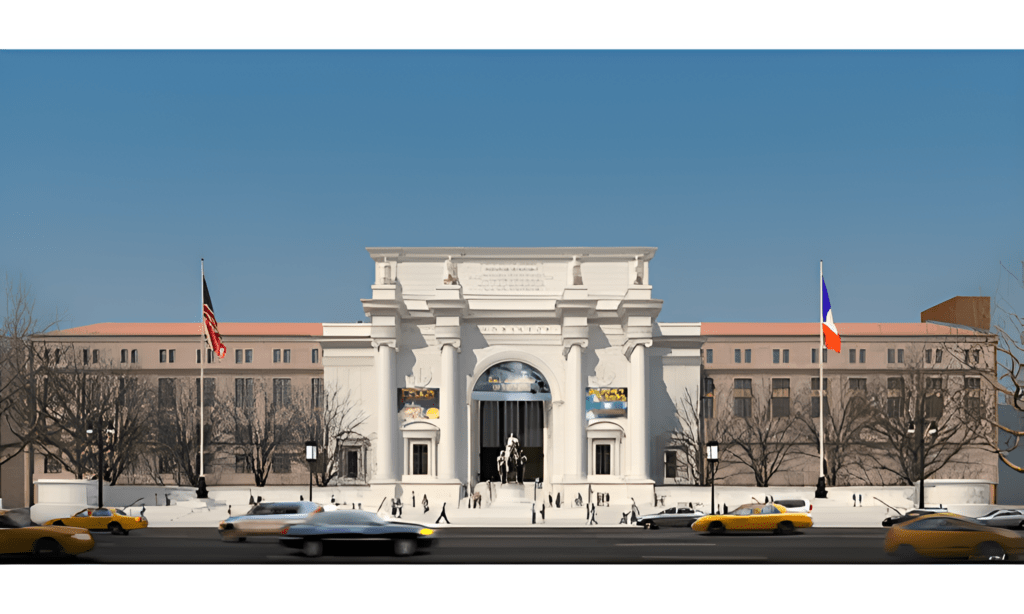The American Museum of Natural History (AMNH) is one of the biggest and most famous museums globally. Established in 1869, this iconic institution on the Upper West Side of Manhattan is a global leader in science, education, and culture. The museum aims to guide visitors through the mysteries of earth science with its extensive research and world-renowned exhibits.
History and Foundation
Founded on April 6, 1869, The AMNH is dedicated to advancing knowledge of the natural world. A group of prominent New Yorkers, including naturalist Albert S. Bickmore and financier J.P. Morgan, founded the museum. Its first president was John David Wolfe. The museum was initially based out of Central Park, in the Arsenal building now known as Ludlow Castle, before being relocated to its current premises back in 1877. The museum quickly grew, both in terms of buildings and its importance as a part of the field centered around natural sciences.
Architecture and Layout
The American Museum of Natural History has 26 connected buildings and an architectural wonder. The museum has since expanded and grown to accommodate over two million square feet within an iconic Beaux-Arts-style structure. The grand entrance, the Theodore Roosevelt Rotunda, is home to a breathtaking expanse of dinosaur skeletons. The museum contains more than 45 permanent exhibition halls, a planetarium, and a library.
Exhibits and Collections
As one of the largest and most celebrated natural history museums in the world, AMNH houses over 34 million specimens and artifacts. Among the objects on view are fossils, minerals, meteorites, and ethnographic artifacts from around the globe. The most popular exhibit is its fossil hall, which boasts a variety of dinosaur skeletons — such as the ubiquitous Tyrannosaurus rex and Apatosaurus. You will also find a vast collection of anthropological artifacts in the museum, displaying cultures from all over the globe.
Along with its permanent exhibits, the AMNH also frequently hosts temporary exhibitions on subjects that range from cutting-edge discovery science to historical and cultural topics. The museum also features the Hayden Planetarium, under astrophysicist Neil deGrasse Tyson. It provides an engaging, in-depth experience that visitors will enjoy, offering a tour of the cosmos through high-def Graphics and commentary.
The Science and Its Contribution
In all, the American Museum of Natural History is a public institution as well as an irreplaceable research center. The research programs conducted by the museum span several fields, such as anthropology, biology, paleontology, and astrophysics. Its more than 100 field expeditions a year are essential to scientific discoveries and insight. The researchers at the AMNH have been instrumental in discovering new species, learning about past civilizations, and investigating climate change.
One of the museum’s most important scientific contributions is, indeed, in this case, on paleontology. The collection includes some of the world’s largest and most complete fossil records. Its paleontology research has made significant contributions to understanding dinosaurs and how they lived, evolved, and went extinct. The scientists of this institution produce publications, conferences, and public lectures that aim to form a more comprehensive world-view.
Educational Outreach
Education was always at the core of the mission of AMNH. There are many programs at the museum that engage family members of all ages. Their signature programs include guided tours and workshops with the ultimate aim to make learning about science a fun thing. One of the museum’s most well-known accomplishments is its Richard Gilder Graduate School, which offers an official PhD in Comparative Biology.
A continuum of programs helps integrate science throughout the curriculum. Through school partnerships, more than 5 million students have learned to think like scientists. The AMNH provides resources and training for educators. Exhibitions at the museum are frequently equipped with lesson plans and other educational assets to assist in that teaching, so they offer excellent resources for educators. Not only are the AMNH’s digital resources — virtual tours and online exhibits — part of its educational outreach, but they also serve to disseminate information worldwide.
Cultural and Global Impact
The AMNH has become an institution that appears in various locations, from films and literature to television. The museum has also been featured in the “Night at the Museum” movies, which have served to introduce this institution to audiences around the world. While beyond fun, the museum’s work on these and other global challenges — from extinction to climate change — has increasingly turned it into an authentic voice in conversations about what will happen next for our planet.
As a part of this, the museum collaborates internationally in efforts dedicated to conservation. The Swaner Preserve and EcoCenter is a non-profit nature preserve, ecological education center, and sustainably built, LEED Platinum-certified building that furthers the living history of the land. The AMNH’s Center for Biodiversity and Conservation conducts essential research into the ways that we can protect our environment, focusing on sustainability — ensuring there are natural resources left behind to pass on to children of future generations!
Visitor Experience
The American Museum of Natural History offers a rich experience, ensuring everyone leaves with something memorable. One of the most visited museums in the world, it had an attendance of over 5 million visitors each year. Visitors leave inspired and curious as they wander through dinosaur-filled halls, uncover mysteries of the mind, and view distant stars in the Omnitheater.
A variety of special events and programs are also available through the museum, including sleepovers, astronomy nights, public lectures, etc. The museum opens its doors at night a few times each month for special events, allowing visitors to experience the exhibits uniquely. Additionally, it offers virtual tours and digital displays, enabling people worldwide to explore its expansive collection remotely.

